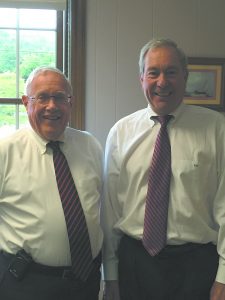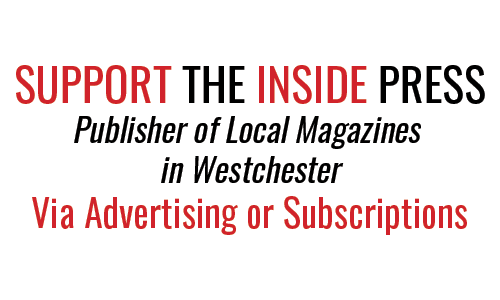Advice from Chappaqua’s Nicolaysen Agency on Tackling Common Insurance Issues
Interview and Photos by Matt Smith

and partner, Randy Coon
In 1929, broker Erik Nicolaysen founded Erik Nicolaysen Insurance. Nearly 30 years later, in 1958, he handed the reins over to his son, Erik Nicolaysen III, who then took charge of the company. In 1972, after a lengthy period of nasty flooding resulted in significant water damage — “we would flood three or four times a year” — Nicolaysen III rebuilt the building on piles from the ground up, and renamed it Nicolaysen Insurance Agency, Inc. And, of course, both that very building and the business still proudly stand today.
Below, Mr. Nicolaysen and Randy Coon, his insurance partner since the early ‘90s, discuss the questions they receive most from New Castle families, and offer their advice on how to combat the issues these questions bring up.
What are the most pressing insurance questions or issues facing suburban families?
Nicolaysen: The question of driving, which is a problem with younger children. We do have a major problem with distracted driving and driving under the influence. There was a 14% increase in deaths by vehicle in the first six months of 2015. Additionally, though [driving under the influence of] alcohol remains an issue, now people are [driving under the influence of] other drugs and medication — that has become a growing problem as well. Even with the restriction on cell phones, etc., there are still too many accidents occurring.
Beyond that, I don’t think there are any major pressing issues. Fortunately, up here, we don’t have the same problem of hurricane damage and flood damage as they do along the Long Island shore, or on Long Island itself. It’s mainly a matter of families wanting reassurance that they have adequate insurance. [In terms of questions, homeowners are] usually looking for recommendations as to what kind of coverage is [appropriate]. They’re particularly asking for the amount they need to replace the house. It’s a lifestyle question … [we have to evaluate] do they have jewelry, fur, collectible cars? Are they into boating? That type of stuff. [Mostly, it’s] life insurance questions for families, et cetera.
Coon: I think it’s a question of home valuations: There can be a tremendous difference between market value and rebuilding cost. Of course, we see confusion from the consumer regarding the idea that they should insure for the market value of their home. We must deal with the rebuilding cost, which has a different set of criteria. I think that’s definitely the biggest issue people have when it comes to dealing with personal homeowner insurance. Again, the cost of rebuilding a home (i. e. after a fire) can be dramatically different from the purchase price of that home.
What are the biggest mistakes people make when addressing insurance needs?
Nicolaysen: Usually underinsurance. [Also] inadequate limits and inadequate coverage. Nationwide, about 50% of all homeowners are underinsured. We’ve had losses in the area, whereby [people have sued]. [Depending upon] the amount of insurance that was carried, you periodically see a lawsuit where the [insurance] company is being sued for underinsurance. But again, people take a look at cost [and set limits] and say, “well, this is the maximum I want to spend, no more,” whether or not it provides what they need.
Coon: They’re influenced by low price, which often results in underinsurance. That’s not just in terms of the dwelling limit (which helps to pay for the rebuilding and repair of a home if it’s damaged by a covered hazard) … homeowners may also neglect to insure or underinsure other items, such as collectibles, jewelry, artwork, etc.
Nicolaysen: We see people who own their own homes and they have certain policies … [and then they] come in with minimum limits of liability, protecting them personally. Yet, they’ve got high priced cars, they’ve got a home, et cetera. Some of them may have an umbrella policy (coverage for that personal liability), but their basic auto [insurance policy] is so low, there’s a major gap between one and the other. To be properly insured, the two policies must be contiguous.
Coon: People that employ a full-time domestic have created an exposure that is not covered by a homeowner policy. As agents, we just need to address that issue to protect our clients.
Nicolaysen: [In the case of homeowners repairing damage], to bring in a contractor and rebuild from the basement up is going to cost more than what that house can sell for. So, that’s why we talk about making sure that [people] insure the value [of their home], i. e. what will it really cost to reproduce that house? [Customers consistently] look at the sale price, and equate one as the other; that is dangerous.
How do you recommend people combat being underinsured?
Coon: I think what they should do is take a look at their total exposures, and then really determine what exposures they can self-insure or what deductible [amount] they can handle [paying before the insurance kicks in]. They can [also] increase their deductible [amount] to offset [insurance] costs, [but] that [may have] an impact with some companies [and not so much with others]. Lowering cost should include very careful consideration so as not to increase risk.
In closing, do you have any other final advice, tips, notes, or words of wisdom?
Coon: There’s no exact science to all of this. You call ten different companies and it’s more than likely that you will obtain various potential rebuilding costs. There are insurance carriers and agents that, due to competition, are willing to offer lower limits and, in turn, lower premiums to get the business. Caveat emptor!
Nicolaysen: All insurance policy contracts have a penalty clause in them, which can cause pain if you don’t insure the home to an adequate value. The insurance company won’t say, “All right, you have a $100,000 loss, but you have a half million dollar policy, so we’ll go ahead and pay the $100,000.” What they’re going to say instead is: “you should have had a million, [but] you’ve got a half a million. Therefore, we’re only going to pay you sixty or seventy cents on the dollar of your claim.” There can be a financial penalty if you don’t insure at full value.
Coon: In order to protect your assets from a lawsuit, I would recommend that the clients [make sure that their] overall personal liability limit [is] at least equal [to] their net worth. We would recommend that they leverage their insurance to protect their assets and standard of living. (This type of coverage is provided by an umbrella policy).
Nicolaysen: [I’d say] just make sure their insurance is adequate [enough] for their exposure. That’s really all there is to it.
Currently, Nicolaysen Agency, Inc. — licensed in 15 states — serves the personal insurance needs of 2000+ individuals and families. In addition to personal coverage, Nicolaysen offers business coverage and other financial services. The agency currently represents Chubb, Travelers, Hartford, GMAC, St. Paul, and Selective, to name a few, for personal lines with access to some 30 companies for commercial coverages. Nicolaysen Agency, Inc. is located at 77 S. Greeley Ave. For more information, please visit www.nicolaysenagency.com.
